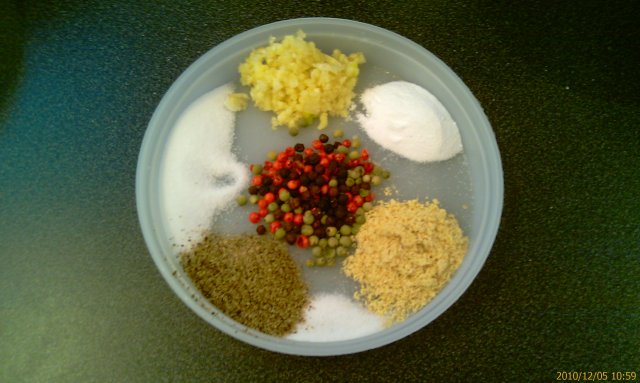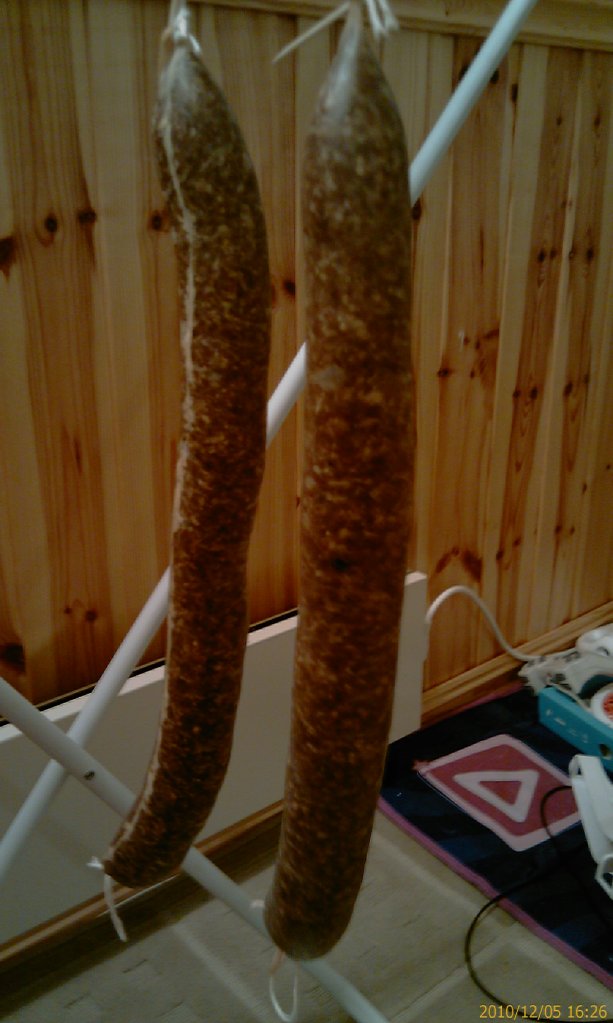BY Maki at Just Bento
Torihamu (鶏ハム)or chicken ham is a recipe that was born and made popular on the internet. It was first popularized around 2001 or 2002, on an extremely popular and often wild and woolly Japanese community/forum site called 2ch or 2-channel (2ちゃんねる), sometime in 2001 or 2002.

Torihamu is a method of cooking chicken breast meat so that it supposedly resembles ham. Nowadays torihamu has entered the mainstream of Japanese culture; there are many recipes for it in regular cookbooks, and the (very mainstream) Cookpad community cooking site has 370 recipes for making torihamu or where torihamu is a main feature – and 650 recipes where it’s an ingredient.
I didn’t try making torihamu for a long time, since I was skeptical that it would actually manage to turn low-fat, bland and often dry chicken breast meat into something ham-like. But I’ve been experimenting with different methods proposed on the Japanese internets, and am now convinced that it’s well worthwhile making, especially for bento lovers. It is low in fat, has no chemical preservatives, and really lengthens the refrigerator shelf life of chicken. There’s not much difference time and effort wise between making one or several, so it’s really best to make a batch and freeze the extras. I make some when there is a sale on chicken breasts.
So, does it really make white chickem meat turn into ham? Well…that depends on your understanding of what ham should be like. I’d say yes, the torihamu does somewhat resemble cold cuts made from chicken or turkey meat.
Recipe and method: Torihamu or homemade chicken “ham”
Note: I’ve given pretty detailed instructions here, so this recipe may seem long, but each step is quite easy and takes only a few minutes. However, the whole process takes 2 days plus cooking and cooling time. I’ve given a suggested schedule below for making this so you have a decent supply for the upcoming week if you wish.
This assumes that you are using boneless, skinned chicken breasts that weigh around 250g or about half a pound each. Adjust the quantities a bit for larger or smaller chicken breasts.
For each 250g or half-pound (8 ounce) boneless, whole skinned chicken breast use:
- 1 tbs. honey – the clear or more solid type, it doesn’t matter
- 1 1/2 tsp. sea salt
- Coarsely ground black pepper
- Dried herbs of your choice
Supplies needed:
- Microwave-safe plastic cling film
- Ziplock bags or vacuum sealing bags
- Optional: kitchen twine.
Step One: Prepping and marinating the chicken
Trim off any fat or sinews on the chicken breasts. You may want to cut them in half if they are much bigger than half a pound each.
In a sturdy ziplock bag or vacuum sealing bag, put in the amount of honey and salt that you need for the amount of chicken breast you’ll be processing. For instance if you have 4 breasts use 4 tablespoons of honey and 6 teaspoons of salt. Squish the bag around a bit to mix the honey and salt. Alternatively, you can assign one chicken breast per bag (do this if you want to experiment with different herb/spice flavors), in which case each bag should have 1 tbs. of honey and 1 1/2 tsp. of salt.
Put the chicken breasts in, one by one, and squish them around in the bag to completely coat them completely with the honey-salt mixture. At this point you can add the black pepper and/or any herbs or spices that you like to the bag with the chicken. I like dried thyme the best. You can try tarragon, crushed red chili peppers, “steak mix” spices, any of Emeril’s best, and so on. For the most versatile and neutral flavor though, stick to just black pepper. Once the herbs and spices are added, squish the chicken in the bag aroun again to coat.
Squeeze out as much air as you can, or suck the air out with your vacuum packing appliance. Seal the bags, and leave the chicken to marinate in the refrigerator for 48 hours or 2 full days. (You can vary this time, as I’ll explain in the Variations below.)
Step Two: De-salinating the chicken
Once they are done marinating, take the chicken breasts out of the ziplock bag or bags, and rinse the chicken well under cold running water. Then, leave the breasts to soak in plenty of cold water, for 1 hour. This soaking process gets rid of excess salt, or de-salinates them, while still leaving enough salt in them so that they are nicely flavored.
From this point, use one of the following cooking methods: 3a, 3b or 3c — not all!
Step 3a: Cooking the chicken: Poaching method
Once the chicken is soaked, it’s time to cook them finally! This is the basic boiling or poaching method that is used in the original torihamu recipes.
Bring a pot of water to a boil. Once it’s come to a boil, reduce the heat to the lowest setting you can manage.
In the meantime, wipe the excess moisture off each chicken breast thoroughly with kitchen or paper towels. Lay each breast flat on a piece of microwave-safe plastic wrap/cling film. At this point, you can add some herbs or seasonings if you like. For instance, if you marinated your chicken with some thyme, add a bit more thyme here (though the chicken itself will have a subtle thyme flavor from the marinating, so you can just leave it plain if you like).
Roll the chicken breast up into a tight little roll, and wrap the plastic wrap around it tightly. Seal off the edges by twisting them, like a candy wrapper.
You may want to tie something around the twisted ends for extra security, but this is not totally necessary. To make the chicken really keep a nice round shape, wrap some kitchen twine or string around it.
Put the wrapped and tied up chicken into the hot and barely simmering water. Cook for 5 minutes, then put a tight fitting lid on the pot and turn the heat off. Leave the chicken to poach for at least an hour. Some people recommend leaving the chicken in until the water has cooled down, but I prefer to take it out before that.
Step 3b: Cooking the chicken: Bare naked poached chicken method
Alternatively, you can skip the plastic wrap and just poach the chicken breasts naked. This results in slightly less finely textured torihamu, but you get an added bonus – the cooking liquid can be used later as stock for other dishes. It’s also the most fuss-free method since there’s no tying and wrapping.
Bring a pot of water up to a boil as with Step 3a, with some salt added — about the strength you might use for cooking pasta. You can also add some aromatic vegetables here, such as leek, parsley, fresh ginger, and so on, if you like.
Once the water has come to a boil, lower the heat and put in the chicken breasts. Cook for 5 minutes, then put a tight fitting lid on the pot and turn the heat off. Leave the chicken to poach for at least an hour. Some people recommend leaving the chicken in until the water has cooled down, but I prefer to take it out before that.
Step 3c: Cooking the chicken: Oven method
This is my favorite cooking method, because I think it results in a much finer textured torihamu.
Preheat the oven to 120 °C / 250 °F. Yes, it’s quite a low temperature – you’ll be cooking the chicken slowly, so that it doesn’t get dried out. Line a baking sheet with kitchen cooking parchment or a non-stick baking liner, or lightly oil the sheet.
After washing and soaking the chicken breasts, wipe off any excess moisture with paper towels. You can roll up the chicken breasts and tie them up with kitchen twine to get a nice round shape, or just leave the breasts as-is. Put the breasts on the lined baking sheet.
[Update:] Rebecca from New Zealand sent in her photo of a properly tied-up chicken breast. Thank you Rebecca!! (I confess that I usually just wind the string around and around the breast rather sloppily.)

Bake the chicken breasts for 35 to 40 minutes, until the surface is a very light brown. (The exact and squeamish amongst you may want to check the internal temperature with a meat thermometer; it should have reached 73 °C or 165 °F.) Take the chicken out and leave to cool on a plate.
So how does the chicken turn out?
Here is a closeup of poached torihamu, using method 3a. The black specks are black pepper by the way.

The flavor of poached torihamu is subtle but good. Poached torihamu is much improved with a little soy sauce and wasabi (wasabi joyu), or even a bit of sriracha sauce, ketchup, etc. Poached torihamu makes terrific chicken salad.
And here’s how the oven baked torihamu looks, using method 3c.

As you can see, there’s a subtle pink flavor, and the texture of the meat is finer. It really does have the texture of some commercially available chicken cold cuts – but with no additives or mystery ingredients! Baked torihamu is great without any additional sauce and such (it’s a bit saltier I find than the poached kind) and in sandwiches. They are a great bento protein just as-is, and you can also add it to stir fries and such.
The in-a-nutshell version of this recipe
I’ve put in a lot of description here to make everything as clear as possible, but it’s really a dead simple recipe:
- Season the chicken with salt and honey or sugar, plus herbs and spices of your choice
- Marinate for 48 hours
- Wash off surface salt and soak to de-salinate
- Cook by poaching or baking
Keeping the torihamu
Torihamu will keep for up to a week in the refrigerator. This makes it ideal for people watching their weight who rely on chicken breast a lot, students, or – yes you, the bentoist! Torihamu can also be frozen very successfully. Just wrap each one individually, and take out to defrost in the refrigerator some hours before you will need it rather than in the microwave, to preserve the texture.
Some suggested ways to eat torihamu
- Just slice and eat (or pack into a bento box) as-is!
- If it is lacking in salt for you, try dipping the slices into a little soy sauce with wasabi or mustard
- Make a very tasty chicken salad from it
- The roasted version in particular makes great sandwiches
- Serve sliced on crackers or on its own as hors d’oeuvres or apero
- Slice and serve on a bed of greens
- Cut up and use in stir-fries, fried rice, etc. as you might ham
Suggested schedule for making torihamu so you have a good supply for a week of bentos
- Buy your chicken breasts on Thursday (or defrost them)
- Salt and honey or sugar them on Thursday evening
- Marinate from Thursday evening to Saturday evening or Sunday morning (a few more hours won’t make a big difference)
- Cook on Sunday
- Enjoy throughout the week (freeze the excess)
Variations
You can marinate the chicken for less or more time, but no less than 5 hours and more than 72 hours or 3 full days. If you only marinate it a short time, you can skip the soaking in water/de-salinating process, but the chicken will not have as full a flavor. If you soak it for a long time, increase the de-salination soaking time to up to 2 hours.
You can use sugar (for every 1 tablepoon of honey suggested in the basic recipe, substitute 1 1/2 tablespoons of sugar) – white, brown or whatever you have – instead of the honey. You can try other sweeteners too, but I would suggest staying away from artificial sugar substitutes. And try whatever spices and herbs appeal to you! My favorites are thyme, tarragon, and rosemary, though I think my favorite addition to the salt and honey is just some black pepper.

























